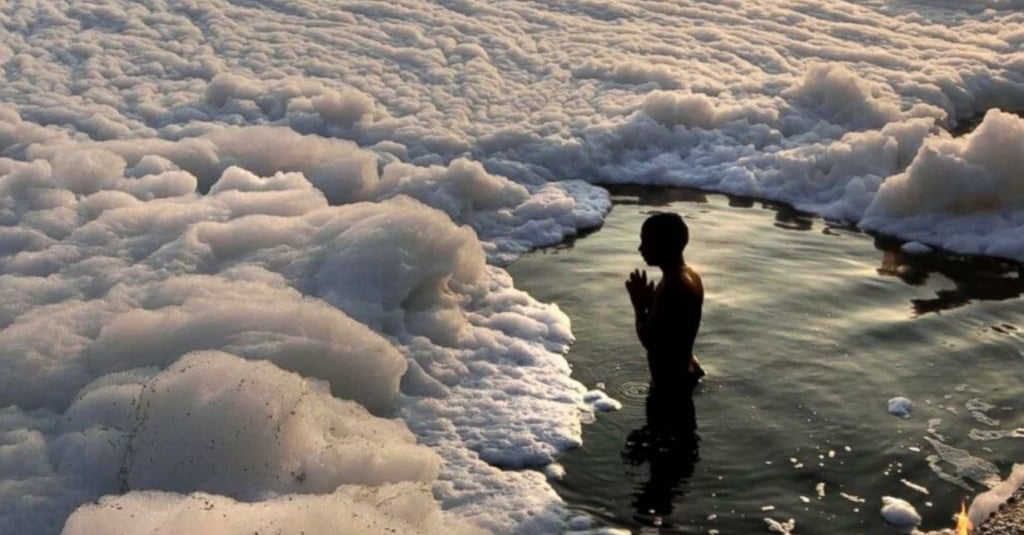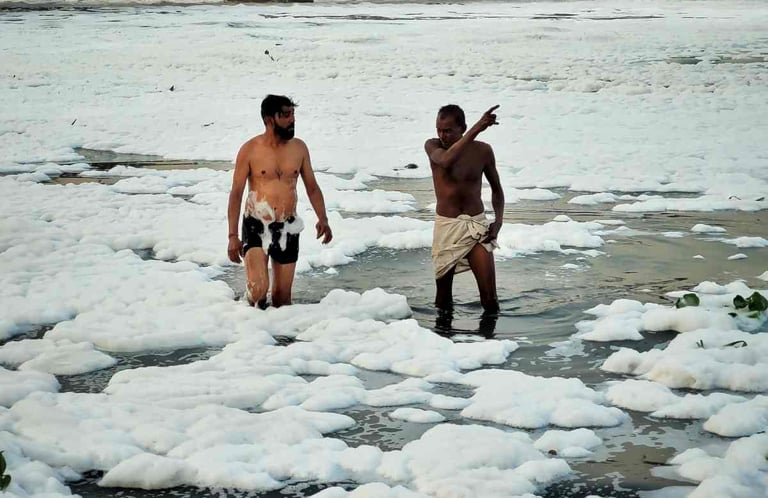Yamuna River Faces Alarming Bacteria Levels Putting Environment and People at Risk
The Yamuna River is more than just a waterway in India. It is a lifeline for millions of people, a source of water for homes and farms, and a sacred river in many cultures. But today, the river is in deep trouble. Recent tests have shown that bacteria levels in the Yamuna have skyrocketed over 4,000 times higher than what is considered safe. This shocking discovery has raised serious concerns about the health of the river and the people who depend on it.
NATIONAL
Thinkbrief
7/19/20253 min read


In July 2025, the Delhi Pollution Control Committee tested water at the ITO Bridge in Delhi. They found faecal coliform bacteria, which come from sewage, at 92 million MPN per 100 millilitres. To put this in perspective, the safe limit is just 2,500 MPN. This means the river is heavily polluted with untreated waste, making it unsafe for anyone to use or even come in contact with.
These bacteria indicate the presence of harmful pathogens that can cause serious illnesses. The river is being overwhelmed by untreated sewage, industrial waste and other pollutants. The consequences extend beyond the water itself. This pollution threatens the river’s aquatic life and the health of the communities that rely on the Yamuna for drinking water, irrigation and religious rituals.
The situation is even more alarming when we look at other signs of pollution. Biochemical Oxygen Demand (BOD) measures how much oxygen is needed by bacteria to break down organic matter. When BOD is high, it means the water is full of pollutants. At the point where the Yamuna enters Delhi, BOD was found to be almost three times above the safe limit. Further downstream at the ITO site, BOD levels reached 70 mg per litre which is extremely dangerous.
This high level of pollution means the river’s oxygen is being used up very quickly by bacteria as they consume all the organic waste. Fish and other creatures need oxygen to survive, but at one point in the river called Wazirabad, oxygen levels dropped so low that aquatic life is struggling to live. In some areas, oxygen is completely gone, creating “dead zones” where nothing can survive.
Part of the problem comes from the sewage treatment plants that are supposed to clean the wastewater before it reaches the river. Unfortunately, many of these plants are not working properly. Almost half of Delhi’s sewage treatment plants failed to meet required standards in 2025. As a result, a lot of untreated or poorly treated sewage flows directly into the Yamuna.
These treatment plants face several challenges. Some are old and outdated, others lack proper maintenance and many cannot handle the growing volume of sewage from the city’s expanding population. Despite government investment, this weak link continues to allow dangerous pollution into the river.
This is not a sudden problem. Pollution in the Yamuna has been a concern for years, but recent data shows it is getting worse. Last year the bacterial levels were already high but this year they have increased even more, especially in central Delhi. This trend highlights the need for urgent action because current cleanup efforts are clearly not enough.
The health risks from such polluted water are serious. Contaminated water can spread diseases like cholera, dysentery, typhoid and hepatitis. This is particularly worrying for people living near the river who use the water for bathing, washing clothes or even drinking with minimal treatment. Children and older people are especially vulnerable.
Agriculture is also at risk. Polluted water used for irrigation can contaminate crops affecting food safety and farmers’ livelihoods. The river’s poor health threatens the entire ecosystem, including the fish and wildlife that live in and around it. When oxygen disappears from the water, fish die off and this upsets the natural balance of the river.
Algae growth caused by excess nutrients from sewage can choke the river further creating a cycle that worsens pollution and kills aquatic life. Toxic chemicals from industries add yet another danger potentially causing long-lasting damage to the environment.
Experts and environmentalists are calling for immediate and comprehensive action. Fixing the sewage treatment plants is a priority. They need to be upgraded, well maintained and run at full capacity. At the same time, stricter rules must be enforced on industries to prevent them from dumping harmful waste into the river.
Public awareness is also key. People need to understand the risks and work together to keep the river clean. Improving sanitation and waste management in cities can help reduce the flow of untreated sewage into the Yamuna.
The government has responded with plans to improve pollution control by using modern technology such as real-time monitoring of water quality and automated treatment plants. But success depends on more than just technology. Political will, funding and cooperation between government agencies, industries, communities and citizens are essential.
If decisive steps are not taken soon the Yamuna will continue to suffer. This would have devastating effects not only on the environment but also on millions of people who rely on the river for their daily lives. Restoring the Yamuna is a complex challenge that requires everyone to work together.
The story of the Yamuna is a reminder that our natural resources are fragile and interconnected with our health and future. Saving this river means protecting the people who depend on it and honoring the cultural and ecological heritage it represents. It is a challenge that calls for urgent action and a shared commitment to a cleaner, healthier future.

